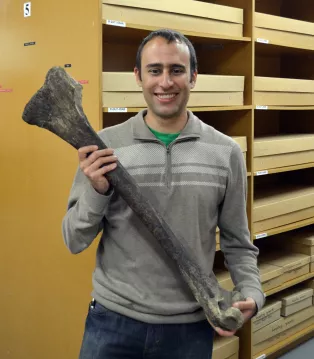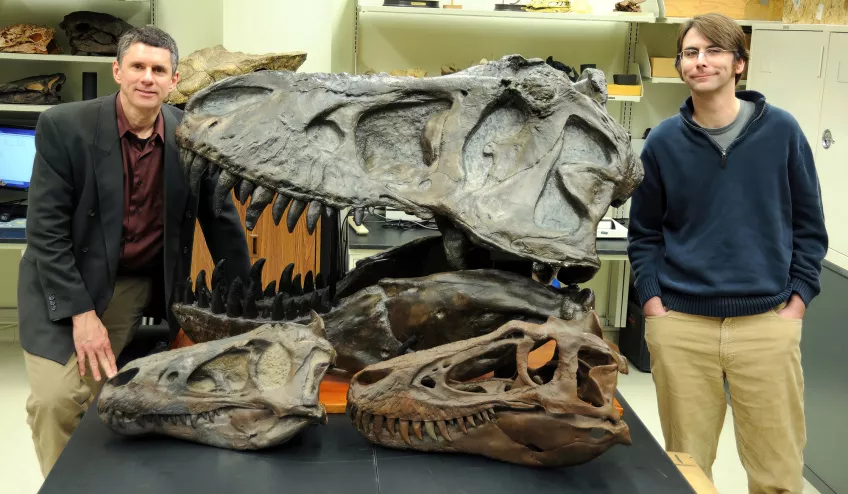Team - Palaeontology
Edinburgh:
Stephen Brusatte, PI
Adam Manning, PhD-student
Ohio:
Lawrence Witmer, PI
Ryan Ridgely, MA, Research Associate
Stephen Brusatte, PI
Professor of Palaeontology and Evolution
University of Edinburgh
stephen [dot] brusatte [at] ed [dot] ac [dot] uk
I am a palaeontologist and evolutionary biologist who studies the anatomy, phylogeny, and evolution of fossil vertebrates, particularly dinosaurs, birds, and mammals. Among my research interests are building large family trees of extinct species, understanding major evolutionary transitions (when organisms drastically change their body plans and expand into new environments), and using computed tomography scanning to study the biology and behaviours of extinct species. I have led studies on how dinosaurs rose to dominance and later went extinct, the origin of birds from theropod dinosaurs, and the diversification of placental mammals after the end-Cretaceous mass extinction. My work is largely field and specimen-based; I have done fieldwork with colleagues around the world and have described over 20 new species of fossil vertebrates. I have written over 150 research papers and several books, including the textbook Dinosaur Paleobiology (2012) and the pop science books The Rise and Fall of the Dinosaurs (2018) and The Rise and Reign of the Mammals (2022). I am a keen communicator of science; I am the ‘resident palaeontologist’ for the BBC’s Walking With Dinosaurs programme, and the palaeontology advisor for the Jurassic World film franchise.
https://www.research.ed.ac.uk/en/persons/steve-brusatte
Adam Manning, PhD student
PhD student
University of Edinburgh
a [dot] c [dot] manning [at] sms [dot] ed [dot] ac [dot] uk
I am a PhD student in the Palaeontology group at School of Geosciences at the University of Edinburgh, Scotland. I have a background in palaeontology, phylogenetics, 3D geometric morphometrics My PhD is investigating how dinosaur brains changed over time. The tissue of the brain does not preserve in fossils, but utilising CT scans of the internal brain cavity, I can build models of the brain cavity as a proxy for the brain. I will then be using advanced statistical methods to quantifiably show how the brains change across the phylogenetic tree of dinosaurs. From this, I will be able to infer the trends in cognitive and sensory ability across dinosaur clades as they evolved through time.
I have always been interested in palaeontology, psychology and behaviour, specifically in reconstructing how extinct animals lived their lives, in a sense, bringing them back to life. I feel very fortunate to be able undertake a project that combines so many of my interests.
Lawrence Witmer, PhD, PI
Professor of Anatomy
Chang Ying-Chien Professor of Paleontology
Ohio University Heritage College of Osteopathic Medicine
witmerL [at] ohio [dot] edu
I am a comparative anatomist, paleontologist, and evolutionary biologist. My lab’s mission is ultimately to “flesh out” dinosaurs and related species, combining classical anatomy with high-tech CT scanning and 3D modeling to shed light on dinosaur biology. For the past almost 30 years, our team has explored numerous functional systems (e.g., jaw muscles and feeding, vascular anatomy and thermal physiology), but our work on the deep-time evolution of neural systems and behavior began in 2003 with an article in Nature on brain structure in pterosaurs and has continued ever since. We’ve published numerous articles on brain endocast structure in all the major groups of crocodilians, dinosaurs, and fossil birds, including diverse ornithischians, sauropods, and theropods. We’ve developed new imaging and quantitative approaches to track brain-surface structure observed today into the fossil record. A key element of our approach is to ground all paleontological inferences in the form and function of modern-day animals. Broadening participation and outreach are also major missions of our lab, and we have a multipronged approach involving everything from lab tours, public programs, and social media to major news releases and television documentaries.
YouTube: http://www.youtube.com/witmerlab
Facebook: http://www.facebook.com/witmerlab
Sketchfab: https://sketchfab.com/witmerlab
Instagram: https://www.instagram.com/witmerlab/
Twitter (@WitmerLab): https://twitter.com/WitmerLab
Ryan Ridgely
Research Associate
Ohio University's Heritage College of Osteopathic Medicine
ridgely [at] ohio [dot] edu



